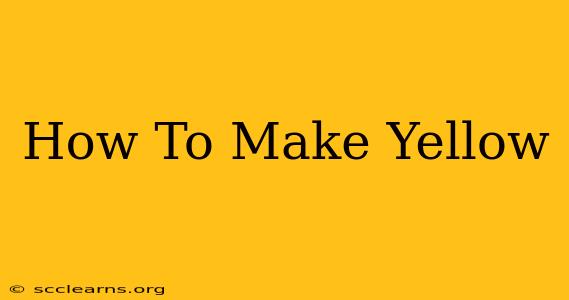Yellow, a vibrant and cheerful color, holds a special place in the spectrum. Whether you're a painter striving for the perfect hue, a food enthusiast aiming for that sunny citrus zest, or a curious individual exploring the science behind color mixing, this guide provides a comprehensive overview of how to make yellow.
Understanding the Basics of Yellow
Before diving into the methods, let's establish a foundational understanding. Yellow, in its purest form, is a primary color. This means it cannot be created by mixing other colors. However, different shades and variations of yellow can be achieved through mixing techniques and the use of different pigments or dyes.
The Spectrum of Yellows
The term "yellow" encompasses a broad range of hues. From the pale lemon yellow to the deep golden yellow, the variations are nearly endless. Factors influencing the final shade include:
- Pigment type: Different pigments produce different shades of yellow. For instance, cadmium yellow offers a brilliant, intense hue, while ochre provides a more earthy, muted tone.
- Mixing ratios: The proportions of colors mixed to create a yellow will significantly affect the final result. A slight alteration can dramatically change the overall shade.
- Light source: The same yellow might appear different under various lighting conditions.
Methods for Making Yellow
Depending on your medium, the approach to creating yellow differs slightly. Here are some common methods:
1. Mixing Yellow with Paints
For painting, achieving the desired yellow depends heavily on your available pigments. You might already have a yellow pigment, or you'll need to mix colors. While pure yellow is a primary color, you can create variations:
- Creating a lighter yellow: Mix your base yellow with white paint. The more white you add, the lighter the yellow becomes.
- Creating a darker yellow: Mix your base yellow with a small amount of brown, black, or a complementary color like violet or blue (depending on the desired effect). A touch of burnt umber or raw umber often creates rich, earthy yellows.
- Creating different shades: Experimenting with the addition of other colors such as orange (red and yellow) or green (blue and yellow) can result in various yellow-orange or yellow-green shades.
2. Creating Yellow in Digital Design
In digital design software like Photoshop or Illustrator, you have more precise control over color creation. You can use the color picker tools to specify your exact hue using hexadecimal codes, RGB values, or HSL values. You can also blend and layer colors for a unique yellow tone.
3. Making Yellow in Food
In the culinary world, achieving a yellow color might involve natural ingredients or food coloring.
- Natural Yellows: Many fruits and vegetables naturally provide yellow hues. Turmeric, saffron, carrots, and bananas are excellent options to consider for adding natural yellows to your dishes.
- Food Colorings: Food-grade yellow colorings are readily available. Remember to follow the instructions provided on the package for the best results.
Tips for Achieving the Perfect Yellow
- Start with small amounts: When mixing, begin with small amounts of each color and gradually add more as needed to avoid wasting materials.
- Experimentation is key: Don't be afraid to experiment with different ratios and combinations to find the perfect shade for your needs.
- Consider the context: The ideal yellow for a painting might not be the best for a cake, so consider your medium and the desired outcome.
- Use quality materials: High-quality pigments or dyes will produce more vibrant and consistent results.
Conclusion
Making yellow, whether in the world of art, cooking, or digital design, is a journey of experimentation and precision. By understanding the underlying principles and employing the techniques outlined above, you can achieve the perfect shade of yellow to suit your specific needs. So grab your paints, ingredients, or digital tools, and start creating your own unique yellow masterpieces!

